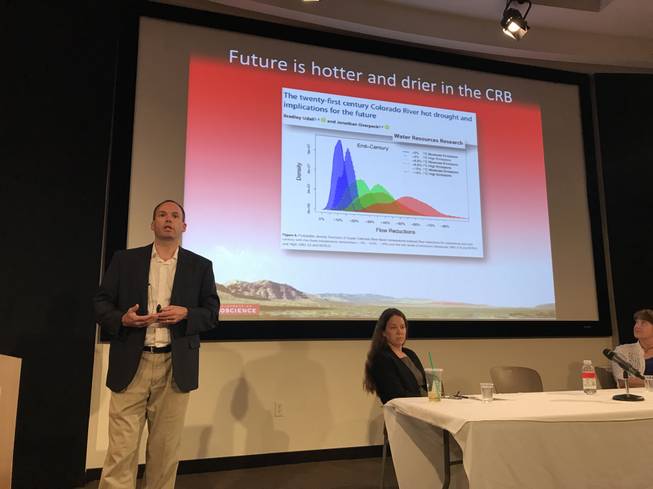
UNLV geoscience expert Matthew Lachniet explains rising temperatures in the West, as Colby Pellegrino, director of water resources at Southern Nevada Water Authority, and Lynn Fenstermaker of Desert Research Institute look on. The trio spoke during a panel discussion on climate and drought at UNLV on June 29, 2017.
Wednesday, July 5, 2017 | 2 a.m.
The effects of global climate change are being felt in the West’s continuing drought, according to a panel discussion at UNLV last week.
Wildfires have increased over the last several years, something one of Colby Pellegrino’s mentors told her years ago would show that climate change is legitimate.
“We’ll know if it’s real, because the West will be on fire long before it hits the watershed,” said Pellegrino, director of water resources at Southern Nevada Water Authority.
Pellegrino said the average temperature was up 8 degrees during March in Colorado, home of the snowcap that feeds the Colorado River and, in turn, Lake Mead. “It clocked in as the warmest temperature for the month in the state of Colorado ever.”
This year’s unseasonably warm temperatures in the West have had sizable impacts on the snowpack in the Rockies this year, Pellegrino said.
“It caused an adjustment in the forecast of over 2 million acre-feet just as a result of the temperatures in March,” she said.
Data recently published on the issue said the drought was caused by temperature changes. In contrast, there was a similar shortage of water in the 1950s, which was caused by the lack of precipitation.
Dr. Matthew Lachniet, a UNLV geoscience expert, said Pellegrino was alluding to what is known as a hot drought. Studying cave deposits from various areas in Nevada, Lachniet and his associates have been able to create a climate history showing how temperature and precipitation have changed over a span of 11,000 years.
“Pretty simple, hot and dry, that’s the pattern for Nevada,” Lachniet said.
A temperature curve created for the 11,000 years of data shows that temperatures peaked about 8,000 years ago and dropped thereafter, but recently the temperature is beginning to rise again, which Lachniet said is the effect of global warming.
“The answer is, yes, it’s really unquestionable that climate is changing and humans are driving it,” he said. “We know that since the 1980s that temperatures have exceeded the long- term means.”
When it gets hot, it gets drier, and the data show that Nevadans can expect to see hotter and drier conditions to persist heading into the future, Lachniet said.
Those higher temperatures will play a big role in the flow of the Colorado River going forward.
“As the temperature increases, we have a greater evaporate and demand and lots of reasons that water gets used up faster,” Lachniet said. “That leads to less water staying in the river system.”
The worst-case scenario shows the Colorado River being at 50 percent less volume in 2100 than what the current levels are.
Lachniet said that humans can play a role in how hot it gets and, in turn, how much water is lost, by reducing greenhouse gases to keep the temperature from rising too dramatically.
States that depend on the Colorado River have worked together to ensure everyone involved is doing their part to conserve as much water as they can.
“The Colorado River is really the hallmark of cooperation for river basins working together,” Pellegrino said. “People from the Colorado River Basin are asked to come all around the world to talk about the way we work together and they way we cooperate.”
Through that work, Pellegrino said they have aggressively advanced the tools needed to adapt to drought,” she said.
They are continuing to work to enforce current guidelines that address shortage in Lake Mead.
“Since 2007, since shortage probabilities of hitting low lake elevations were figured out, we’ve doubled and tripled the probabilities of hitting those same elevations,” she said. “This current drought is throwing us in a place we never thought we would be this quickly.”
Drought contingency planning is the major initiative for the Colorado River Basin members.
The SNWA, the Governor's Office of Economic Development, UNLV, UNR, and MGM Resorts International are among the partners in WaterStart. Initially started to spur economic growth by bringing in new water-smart technology, it has evolved into allowing those entities to develop water-conservation technology.
“We provide grant funding to help get those things off the ground and are able to test them,” Pellegrino said.
The latest project being tested is a water-smart meter used by some of Nevada’s largest water users.
The meters provide information about water usage at large resorts and institutions. The data can then be used to address any issues relating to water conservation to be as efficient as possible.
“We can go back and digest it and evolve our programs to continue to tackle water use and achieve conservation where it makes sense,” she said.
Infrastructure improvements such as adding a third intake at Lake Mead and a new associated pumping station with that are other ways SNWA is taking the proactive approach.
“By the end of 2020 we’ll be able to pump from a level in Lake Mead that provides better water quality than we have now,” she said. “We’re already starting to access that portion of a project — the ability to pump water from the Colorado River, even if there’s not enough water in Lake Mead to deliver it downstream.”
The project’s $1.4 billion cost was financed without any state or federal funding.
“The local community needs to be willing to put in those kind of investments, and we’re really fortunate to be ahead of the game there,” she said.
CORRECTION: This version of the story corrects the spelling of Colby Pellegrino's name. | (July 5, 2017)

Join the Discussion:
Check this out for a full explanation of our conversion to the LiveFyre commenting system and instructions on how to sign up for an account.
Full comments policy